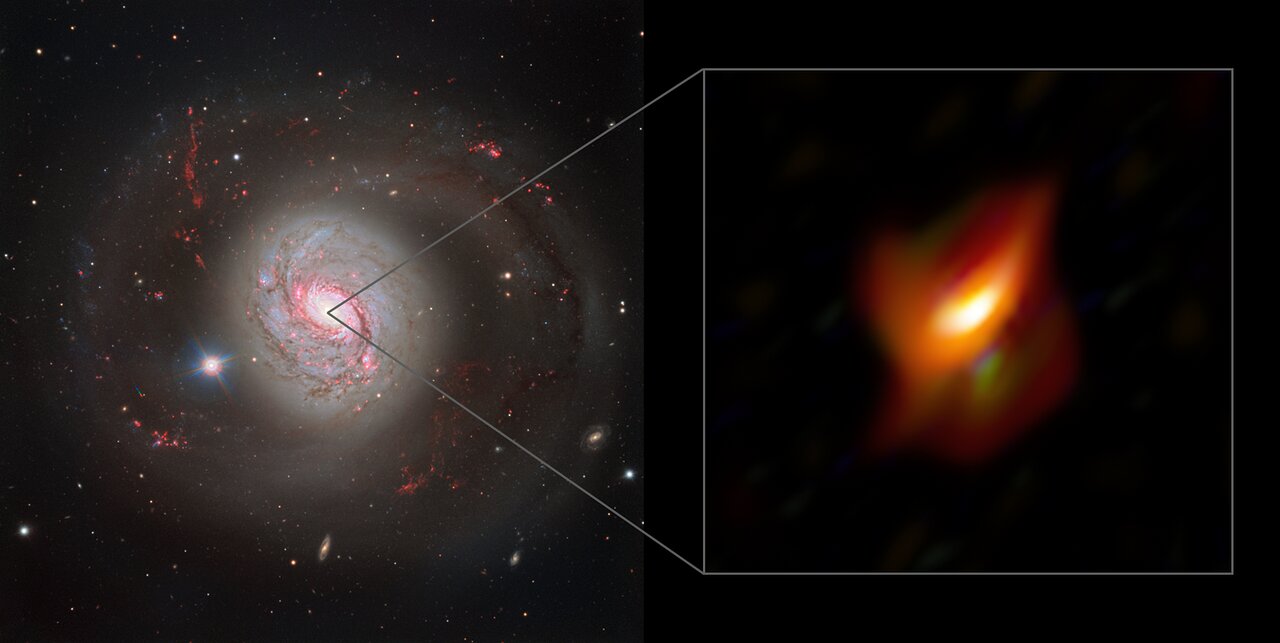Scientists spot supermassive black hole hiding inside thick cosmic dust
A supermassive black hole masked by a cloud of cosmic dust was found at the center of an active galaxy in new images from the European Southern Observatory (ESO).
The galaxy, known as Messier 77 or NGC 1068, is a barred spiral galaxy located about 47 million light-years from Earth, in the constellation Cetus. Taken by the ESO's Very Large Telescope Interferometer (VLTI) in northern Chile, the observations shed new light on galaxies that have an active galactic nucleus (AGN) at their core. These bright features are fueled by all the gas and dust that falls into the galaxy's central black hole, causing the area to outshine the rest of the galaxy.
"Our results should lead to a better understanding of the inner workings of AGNs," Violeta Gámez Rosas, lead author of the study from Leiden University in the Netherlands, said in a statement from the ESO. "They could also help us better understand the history of the Milky Way, which harbors a supermassive black hole at its center that may have been active in the past."
Related: Amazing space views of ESO's Very Large Telescope (photos)

The recent image, taken using the Multi Aperture Mid-Infrared Spectroscopic Experiment (MATISSE) mounted on ESO's VLTI, revealed a thick ring of cosmic dust and gas concealing a supermassive black hole at the galaxy's core. The findings support a principle called the Unified Model of AGN, which holds that all AGNs have the same structure, but may look different based on how they are viewed from Earth.
"The real nature of the dust clouds and their role in both feeding the black hole and determining how it looks when viewed from Earth have been central questions in AGN studies over the last three decades," Gámez Rosas said in the statement. "Whilst no single result will settle all the questions we have, we have taken a major step in understanding how AGNs work."

The brightness of an AGN varies depending on how much light from the central black hole is obscured by surrounding dust and gas. In this case, Messier 77 appears more subdued than other AGNs because the thick ring of dust and gas completely hides the black hole from our view.
Get the Space.com Newsletter
Breaking space news, the latest updates on rocket launches, skywatching events and more!
However, the MATISSE instrument can see a broad range of infrared wavelengths, allowing researchers to peer through the thick, dusty ring. With this technique, the team was able to measure differences in the temperature of the dust (caused by radiation from the black hole), as well as absorption of the dust clouds around the black hole. This, in turn, allowed the scientists to pinpoint the location of the black hole in Messier 77, according to the statement.
Data from the Atacama Large Millimeter/submillimeter Array and the National Radio Astronomy Observatory's Very Long Baseline Array was also used to create the new detailed view of Messier 77.
"Messier 77 is an important prototype AGN and a wonderful motivation to expand our observing program and to optimize MATISSE to tackle a wider sample of AGNs," Bruno Lopez, co-author and MATISSE Principal Investigator at the Observatoire de la Côte d'Azur in Nice, France, said in the statement.
The findings were published Wednesday (Feb. 16) in the journal Nature.
Follow Samantha Mathewson @Sam_Ashley13. Follow us on Twitter @Spacedotcom and on Facebook.
Join our Space Forums to keep talking space on the latest missions, night sky and more! And if you have a news tip, correction or comment, let us know at: community@space.com.

Samantha Mathewson joined Space.com as an intern in the summer of 2016. She received a B.A. in Journalism and Environmental Science at the University of New Haven, in Connecticut. Previously, her work has been published in Nature World News. When not writing or reading about science, Samantha enjoys traveling to new places and taking photos! You can follow her on Twitter @Sam_Ashley13.








